Scroll down for photo gallery
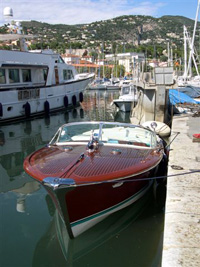 Photo copyright Mario Marchesini. A Riva Aquarama waits for the event at Imperia. Photo copyright Mario Marchesini. A Riva Aquarama waits for the event at Imperia.
|
It has been said, far too often by far too many, that Riva is the Ferrari of speedboats.
Hyperbole, surely, a well worn phrase to catch a wider audience. Please, enough, we say.
But there is something here, enough to warrant a closer look, and an excuse to write an article about Rivas.
When viewing a Riva speedboat from the 1950s, one can't help to think about the craft in terms of Ferraris of the same vintage. The feeling is subjective, almost ethereal. Just look at it. The lines, the intent, the quality, the exclusivity, the power and, of course, the glory of a mahogany Riva bring forth images of perhaps a Ghia showcar. The Ghia Gilda, 0473SA, built for Bob Wilke comes to mind, or in some cases a 250GT California; it is difficult to envisage the most appropriate Ferrari. But the evocation is clear.
A Long History
The Riva company is far older than Ferrari. In 1842, a young man from Sarnico by the name of Pietro Riva started to repair boats damaged from storms which occurred on the nearby Lake d'Iseo.
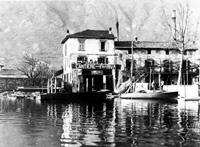 Cantieri (boatyard) Riva in 1922, when Serafino Riva was head of the company. Photo courtesy Riva. Cantieri (boatyard) Riva in 1922, when Serafino Riva was head of the company. Photo courtesy Riva.
|
This blossomed into a shipyard which built high quality boats. This legacy of quality established by the first Riva continues to this day. Pietro's son Ernesto took over the company in 1880, maintaining the reputation for quality, while at the same time becoming known for his innovative techniques, including the use of internal combustion engines to power the boats.
Ernesto's son Serafino took an active role in motorboat racing, and Riva boats won many international events in the 1930s. But, after a while, his interest waned, and his son Carlo, born in 1922, wanted to contribute new designs, many unlike the traditional boats Serafino was building. This conflict erupted in 1950, when young Carlo said, "Hey, either accept my designs or shoot me" (or words to that effect). Father and son worked things out, and by 1954 Carlo had established a worldwide reputation for his speedboats, which were heavily influenced by the creations of Chris-Craft.
Carlo Riva
From the early 50s, when Carlo Riva had to beg for funding (Signor Beretta, of the famous gun company, who owned a house on Lake d'Iseo provided loans to Riva which helped him re-establish Cantieri Riva), to 1969, when labor problems saw him locked out of his factory, the paths of Enzo Ferrari and Carlo Riva were similar. Like Ferrari, Carlo Riva was in total control of the post-war fiefdom he had created, and catered to, but was not humbled by kings and wealthy patrons. Riva once told a King he could not take delivery of his new Riva until full payment had been made.
The list of the rich and famous who have owned Rivas often overlap those who also bought Ferraris; Brigitte Bardot, Sean Connery, Peter Sellers, Prince Ranier of Monaco, King Hussein, the Shah of Persia, Carlo Ponti and Sophia Loren, and the King of Sweden, who still owns one today.
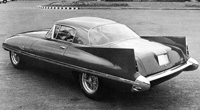 What Ferrari comes to mind when you look at a Riva? Here's one--the Ghia Gilda, a boat, perhaps, a plane, but also a Ferrari. What Ferrari comes to mind when you look at a Riva? Here's one--the Ghia Gilda, a boat, perhaps, a plane, but also a Ferrari.
|
In the mid 1960s, during his European heydays, Henry Ford II met Carlo Riva. Henry understood the fragile and difficult father-son relationship they had both endured, and Riva had based his business philosophy on that of Ford. Ferrari's encounters with the Ford Motor company, of course, were not as sympathetic.
In the late 1960s, Riva faced another, even greater challenge than union problems ... that of a technology that was both beyond his control and yet beyond his tolerance to accept. The widespread use of fiberglass in the boating industry turned his wooden boats into relics. While Ferrari dealt with the unstoppable rear-engined-revolution, Carlo knew the time for wooden boats was at an end, and adopted the new technology. They both faced the future and went forward.
In one way, however, Riva boats were the opposite of Ferrari, and much more like Iso Rivolta... he used American engines to power his graceful speedboats. Ironically, Piero Rivolta is now building yachts in Florida! In the early 1950s, no Italian engine met the requirement of a marine powerplant. Even small boats need a lot of grunt to get through the water. The Ferrari 4.5 V12 had the power but obviously was far too expensive, even if Riva had cut a deal with Enzo. The Maserati V-8 wasn't widely available until the 1970s. In 1952, Riva approached Chris-Craft about using his engines, and did so until Cadillac and Chrysler engines became feasible.
In 1969, as Enzo Ferrari sold the production side of the business to Fiat, Carlo Riva decided to sell his entire company to Whittaker, another boat builder. The Riva brand and quality continued, despite numerous owners over the years. Riva is now part of Gruppo Ferrett, and still makes some of the world's greatest boats and yachts. But the great little wooden speedboats are no longer available. Only 3760 were made by Riva while under the guidance of Carlo Riva. And, like Ferraris, all are collector items today, and worth a small fortune.
A Rocky Road to a Non Event
Events for Riva speedboats are held in many places around the world, as owners gather much like members of the Ferrari clubs. One such event was scheduled to be held on September 9-11th at Imperia on the the Italian "Riviera dei Fiori", midway between Genoa and Monte Carlo.
Every two years the port authorities and the yachting club of Imperia organize a historic boating weekend.
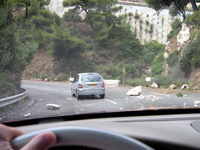 Photo copyright Mario Marchesini. Dodging boulders on the Riviera. Photo copyright Mario Marchesini. Dodging boulders on the Riviera.
|
Our correspondent, Mario Marchesini, found getting there a bit tough. He drove his Cadillac (Mario, who lives in Italy, imported a Cadillac from the U.S. to Italy. His brother Lorenzo, who lives in the U.S., imported a Lancia from Italy to the U.S.) to the event but found the road full of fallen rock. We'll let him explain. "In occasion of the biennial historic motor yacht meeting in Imperia (Italian
Riviera) this year they also organised a "raid" Villefranche/Imperia only for
Riva speedboats. I drove to Villefranche
(French Riviera), and arrived there just after a very, very heavy
thunderstorm passed over that small town. For the same reason the Italian
organization decided to cancel the raid, put all the Rivas on trailers and
brought them back to Imperia. Never the less I arrived in time to make the
next photos."
For more information about Riva, see Riva-Yacht.com
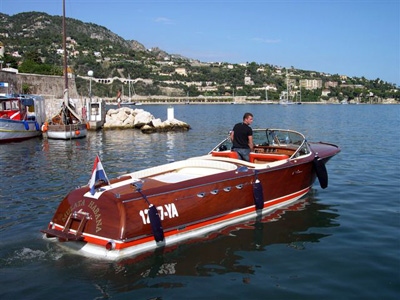 Photo copyright Mario Marchesini. The Riva Aquarama was the most famous and desirable of the mid60s mahogany Rivas. Always equipped with twin engines, the Aquarama was built from 1962 to 1996. Photo copyright Mario Marchesini. The Riva Aquarama was the most famous and desirable of the mid60s mahogany Rivas. Always equipped with twin engines, the Aquarama was built from 1962 to 1996.
|
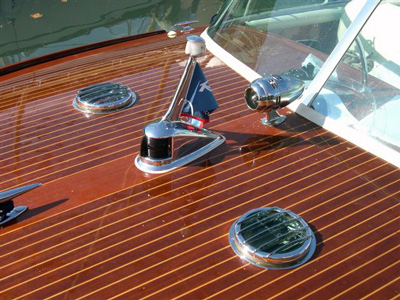 Photo copyright Mario Marchesini. A detail of the deck of the Aquarama provides some inkling of the quality of the workmanship. Carlo Riva worked hard to ensure only the finest materials were used throughout the boat. Photo copyright Mario Marchesini. A detail of the deck of the Aquarama provides some inkling of the quality of the workmanship. Carlo Riva worked hard to ensure only the finest materials were used throughout the boat.
|
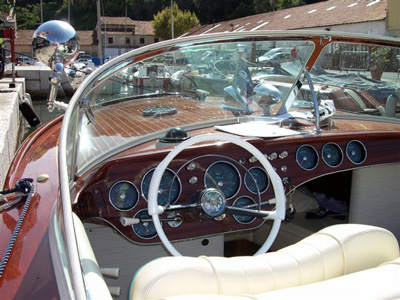 Photo copyright Mario Marchesini. In 1964, Riva began to use German VDO instruments, but insisted they meet all of the qualifications necessary for sea. Carlo Riva would smash the instruments if they failed to work correctly, until VDO finally got it right. Photo copyright Mario Marchesini. In 1964, Riva began to use German VDO instruments, but insisted they meet all of the qualifications necessary for sea. Carlo Riva would smash the instruments if they failed to work correctly, until VDO finally got it right.
|
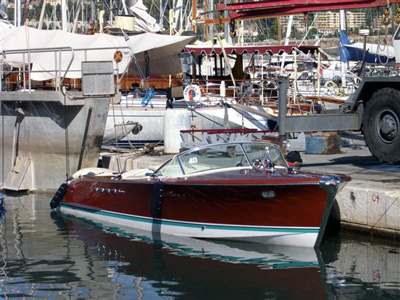 Photo copyright Mario Marchesini. This 1970 Riva Aquarama
ran two Chrysler V-8s, modified by Riva to produce 270hp each. Photo copyright Mario Marchesini. This 1970 Riva Aquarama
ran two Chrysler V-8s, modified by Riva to produce 270hp each.
|
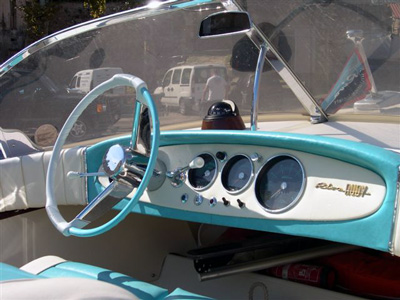 Photo copyright Mario Marchesini. In the late 1960s, production of fiberglass Rivas increased. This is the Rudy model, of which 364 were built from 1972 to 1986. Photo copyright Mario Marchesini. In the late 1960s, production of fiberglass Rivas increased. This is the Rudy model, of which 364 were built from 1972 to 1986.
|
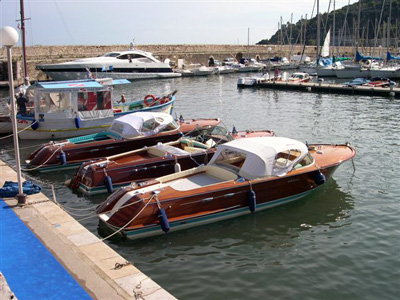 Photo copyright Mario Marchesini. A lineup of three Rivas, showing the top up vs top down positions Photo copyright Mario Marchesini. A lineup of three Rivas, showing the top up vs top down positions
|
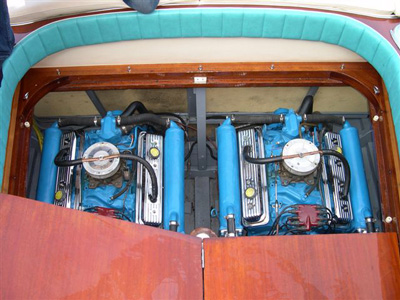 Photo copyright Mario Marchesini.The Chrysler engines in an Aquarama. Each engine was run for 30 hours before final delivery to the customer. Photo copyright Mario Marchesini.The Chrysler engines in an Aquarama. Each engine was run for 30 hours before final delivery to the customer.
|
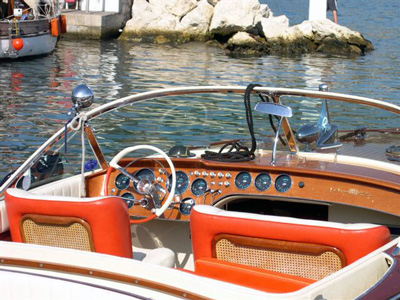 Photo copyright Mario Marchesini. The lavish cockpit of the Aquamara was obviously influenced by Ford rather than Ferrari. Note the basketweave behind the seats, the instruments and the copious chroming. Photo copyright Mario Marchesini. The lavish cockpit of the Aquamara was obviously influenced by Ford rather than Ferrari. Note the basketweave behind the seats, the instruments and the copious chroming.
|
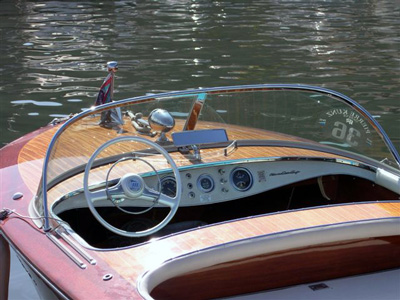 Photo copyright Mario Marchesini. This model, by the looks of the steering wheel, dates from the mid to late 1950s. While the steering wheel looks like it was borrowed from an Alfa or Fiat 1900 GranLuce, Riva had to have specially built wheels for boating use. Photo copyright Mario Marchesini. This model, by the looks of the steering wheel, dates from the mid to late 1950s. While the steering wheel looks like it was borrowed from an Alfa or Fiat 1900 GranLuce, Riva had to have specially built wheels for boating use.
|